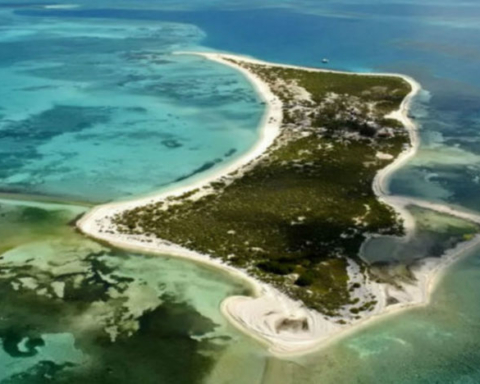CARACTERÍSTICA-Los mayas de México apuntan a reducir la pérdida de especies, el cambio climático
FELIPE CARRILLO PUERTO, México, 30 de diciembre (Fundación Thomson Reuters) – Maria Yam Pérez pelea por los huevos sobre una estufa de madera y ahorra madera y mezcla chaya recién cortada, una planta parecida a la espinaca conocida por su versatilidad en cocina y medicina .
Señala el negro hollín del humo de la chimenea, acumulado debajo del techo de paja, como zarcillos de hilo gris y en las paredes de palo de la cocina al aire libre.
«Cuando una persona tiene sudoración, fiebre, escalofríos, dolores y calambres, se usa como medicina, mezclada con miel, huevos y cal», dijo. «Si vas al médico y no puedes obtener alivio, este es el remedio tradicional de los mayas».
Este día de diciembre es un día festivo de celebración de la Virgen Mexicana de Guadalupe, por lo que más tarde Yam Pérez vestirá indio Maya para unirse a la fiesta, el canto y la danza con su familia y otros 250 en la comunidad de Felipe Carrillo Puerto.
Antes de eso, estaba ocupada preparando el desayuno para un grupo que visitaba el centro de ecoturismo de la comunidad de Sijil Noh Ha, ubicado en el bosque tropical de la Península de Yucatán, al sureste de México, a unos 200 kilómetros al suroeste de Cancún .
Este proyecto, una consecuencia de la empresa forestal de la comunidad, muestra discretamente la sabiduría indígena consagrada que protege la biodiversidad y ayuda a fortalecer la resistencia al cambio climático, un tema candente en las conversaciones sobre la Convención de las Naciones Unidas sobre Diversidad Biológica.
La silvicultura indígena y comunitaria es clave para frenar la extinción de especies y el calentamiento global, por lo que los gobiernos deben hacer más para garantizar los derechos a la tierra de los pueblos de los bosques, así como su participación en la toma de decisiones.
«Participar y apoyar a los pueblos indígenas y las comunidades locales es vital», dijo Maurizio Farhan Ferrari, coordinador de gobernanza ambiental para el Programa de Pueblos Forestales.
«La diversidad biológica y cultural en conjunto aumentan la resiliencia al cambio social, ambiental y climático», dijo Joji Carino, coordinador del grupo de trabajo del Foro Indígena Internacional sobre Biodiversidad.
PÁJAROS Y JAGUARES
Esto es especialmente cierto en países que son ricos en biodiversidad como México. Aquí, en la quinta nación biológicamente más diversa de la tierra, unos 13 millones de personas – aproximadamente la mitad de los 62 pueblos indígenas de México – viven y administran tierras forestales comunitarias, según el Banco Interamericano de Desarrollo.
A través de México y Centroamérica, los pueblos indígenas y las comunidades locales tienen derechos legalmente reconocidos de alrededor del 65 por ciento de los bosques, que contienen uno de los puntos más grandes de diversidad del mundo, el Corredor Biológico Mesoamericano, según Andrew Davis, autor de Conservation and Community Rights , Un libro publicado recientemente por el Programa Regional de Investigación sobre Medio Ambiente y Desarrollo de El Salvador (PRISMA).
La capacidad mundial para cumplir con los objetivos de protección de la biodiversidad será un factor determinante en el éxito del nuevo Acuerdo de París sobre el cambio climático, argumenta la Plataforma Científico-Política Intergubernamental sobre Biodiversidad y Servicios de los Ecosistemas.
La comunidad de Felipe Carrillo Puerto, además de operar empresas madereras certificadas internacionalmente y turismo sostenible, está monitoreando el jaguar en peligro de extinción (Panthera onca), que es de primordial importancia para la cultura indígena maya y el equilibrio de la naturaleza.
Felipe Carrillo Puerto y otras cuatro empresas forestales comunitarias de la Alianza de la Selva Maya están prestando servicios ecosistémicos para conservar la selva tropical más grande de México y Centroamérica, ubicada en el Corredor Biológico Mesoamericano.
Yam Pérez forma parte de un equipo de 15 mujeres y jóvenes que monitorean aves en la alianza, que provee bienes y servicios que cubren un área de casi 213.450 hectáreas.
Los esfuerzos del equipo hacen que el hábitat sea seguro para la reproducción y migración de la fauna silvestre en el tramo de bosque entre las dos reservas de biosfera de Sian Khan y Kalakmul, con el apoyo del Fondo para el Medio Ambiente Mundial.
Los ingresos provenientes de los proyectos turísticos y de los servicios ecosistémicos de la alianza ahora superan los recibos de registro en varios lugares. Para diversificar aún más la cartera, Felipe Carrillo Puerto planea establecer una empresa certificada de aserraderos y muebles.
Y en un proyecto de comercio de carbono – parte de un programa para reducir las emisiones de calentamiento del planeta causadas por la deforestación y la degradación de los bosques, respaldado por el gobierno noruego – los miembros de la comunidad trabajan en bandas de troncos para medir su crecimiento anual.
REFORMA LEGAL
Para asegurar éxitos similares en el terreno, todos los niveles de gobierno necesitan intensificar los esfuerzos para implementar políticas y programas sobre conocimiento tradicional y uso sostenible de los recursos en asociación con pueblos y comunidades indígenas, dicen los expertos.
En la mayoría de los casos, «no ha habido el proceso de consulta necesario», dijo Gustavo Sánchez, presidente de la Red de Organizaciones Forestales Comunitarias Mexicanas (Red Mocaf).
Los pueblos indígenas y las comunidades forestales «han tenido que luchar con fuerza para que se escuchen sus voces y para que se reconozca su derecho al consentimiento libre, previo e informado», dijo Edwin Vásquez Campos de la Coordinación de Organizaciones Indígenas de la Cuenca Amazónica (COICA).
Un estudio publicado este mes sobre la gobernanza forestal por el grupo mexicano de investigación Legislación y política ambiental (Polea) encontró que las leyes y directrices de México deben ser ajustadas y financiadas para hacer más efectivo el modelo de silvicultura comunitaria.
Las próximas iniciativas legislativas ofrecen esa oportunidad, según la Organización Global de Legisladores (GLOBE International), que encargó el estudio.
Esas iniciativas incluyen la reforma integral de la Ley General de Desarrollo Forestal Forestal de México, la creación de una Ley General de Biodiversidad, un proyecto de ley para actualizar el proceso de inspección de violaciones al derecho ambiental y una nueva Ley General del Agua.
Las comisiones del Congreso deben trabajar en conjunto para armonizar esos proyectos de ley y asegurar una amplia participación de los afectados, como el proceso que logró consenso sobre la Ley General de Cambio Climático, la primera ley climática del mundo. (Reporte de Talli Nauman;. Editado en español por Megan Rowling crédito a favor de la Fundación Thomson Reuters, el brazo caritativo de Thomson Reuters, que cubre noticias, derechos de la mujer, la trata, los derechos de propiedad humanitarias y el cambio climático visita. News.trust.org )
FEATURE-Mexico’s Maya point way to slow species loss, climate change
FELIPE CARRILLO PUERTO, Mexico, Dec 30 (Thomson Reuters Foundation) – Maria Yam Pérez scrambles eggs over a wood-saving, earth-block stove and stirs in freshly chopped chaya, a spinach-like jungle plant known for its versatility in cooking and medicine.
She points to the black soot from the hearth smoke, accumulated under the thatched roof, like tendrils of grey gossamer, and on the stick walls of the open-air kitchen.
«When a person has sweating, fever, chills, aches and cramps, this is used as medicine, mixed with honey, eggs and lime,» she said. «If you go to the doctor and can’t get relief, this is the traditional Maya remedy.»
This day in December is a customary holiday celebrating the Mexican Virgin of Guadalupe, so later Yam Pérez will don indigenous Maya dress to join in feasting, song and dance with her family and 250 others in the community of Felipe Carrillo Puerto.
Before that, she was busy making breakfast for a group visiting the community’s eco-tourism centre of Sijil Noh Ha, set deep in the tropical forest of Mexico’s southeastern Yucatan Peninsula, some 200 km (124 miles) southwest of the coastal resort city of Cancún.
The venture, an outgrowth of the community’s forestry enterprise, discreetly showcases time-honoured native wisdom that protects biodiversity and helps build resilience to climate change – a hot topic at talks on the U.N. Convention on Biological Diversity (CBD) held this month in Cancún.
Indigenous and community forestry is key to slowing species extinction and global warming, so governments must do more to guarantee the land rights of forest peoples, as well as their participation in decision-making, experts told the CBD’s 13th major conference.
«Engaging with, and supporting indigenous peoples and local communities, is vital,» said Maurizio Farhan Ferrari, environmental governance coordinator for the Forest Peoples Programme.
«Biological and cultural diversity together increase resilience to social, environmental and climate change,» said Joji Carino, a working group coordinator for the International Indigenous Forum on Biodiversity.
BIRDS AND JAGUARS
This is especially true in countries that are rich in biodiversity like Mexico. Here, in the fifth-most biologically diverse nation on earth, some 13 million people – about half belonging to Mexico’s 62 indigenous peoples – live in, and administer, community forest lands, according to the Inter-American Development Bank.
Across Mexico and Central America, indigenous peoples and local communities have legally recognised rights to around 65 percent of the forests, containing one of the world’s largest diversity hotspots, the Mesoamerican Biological Corridor, according to Andrew Davis, author of «Conservation and Community Rights», a book recently released by El Salvador’s Regional Environment and Development Research Programme (PRISMA).
The world’s ability to meet biodiversity protection targets will be a determining factor in the success of the new Paris Agreement on climate change, argues the Intergovernmental Science-Policy Platform on Biodiversity and Ecosystem Services.
The community of Felipe Carrillo Puerto, besides operating internationally certified lumber and sustainable tourism businesses, is monitoring the endangered jaguar (Panthera onca), which is of primordial importance to the Maya indigenous culture and nature’s balance.
Felipe Carrillo Puerto and four other community forest enterprises in the Maya Jungle Alliance are providing ecosystem services to conserve the largest rainforest in Mexico and Central America, located in the Mesoamerican Biological Corridor.
Yam Pérez is part of a 15-member team of women and youth who monitor birds in the alliance, which provides goods and services covering an area of nearly 213,450 hectares (527,446 acres).
The team’s efforts are making habitat safe for wildlife reproduction and migration in the stretch of woodland between the two biosphere reserves of Sian Khan and Kalakmul, supported by the Global Environment Facility.
Income from the alliance’s tourism projects and ecosystem services now outstrips logging receipts in several places. To diversify the portfolio further, Felipe Carrillo Puerto plans to establish a certified sawmill and furniture-making enterprise.
And in a carbon trading project – part of a programme to reduce planet-warming emissions from deforestation and forest degradation, backed by the Norwegian government – community members work banding tree trunks to measure their annual growth.
LEGAL REFORM
To ensure similar successes on the ground, all levels of government need to step up efforts to implement policy and programmes on traditional knowledge and sustainable use of resources in partnership with indigenous peoples and communities, experts say.
In most cases, «there hasn’t been the necessary consultation process», said Gustavo Sánchez, president of the Network of Mexican Community Forestry Organisations (Red Mocaf).
Indigenous peoples and forest communities «have had to struggle hard to have their voices heard and to have their right to free, prior and informed consent recognised», said Edwin Vásquez Campos of the Coordination of Indigenous Organisations of the Amazon Basin (COICA).
A study issued this month on forest governance by Mexican research group Environmental Legislation and Policy (Polea) found that Mexico’s laws and guidelines must be fine-tuned and financed further to make the community forestry model more effective.
Upcoming legislative initiatives offer that opportunity, according to the Global Legislators Organisation (GLOBE International), which commissioned the study.
Those initiatives include comprehensive reform of Mexico’s General Law on Sustainable Forest Development, the creation of a General Law of Biodiversity, a bill to update the inspection process for environmental law violations, and a new General Law of Water.
Congressional commissions should work together to harmonise those bills and assure ample participation by those affected, as with the process that achieved consensus on Mexico’s General Law on Climate Change, the world’s first national climate law, the analysis concluded. (Reporting by Talli Nauman; editing by Megan Rowling. Please credit the Thomson Reuters Foundation, the charitable arm of Thomson Reuters, that covers humanitarian news, women’s rights, trafficking, property rights and climate change. Visit news.trust.org)






